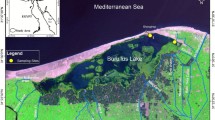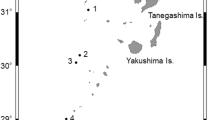Synopsis
Feeding of and food availability for larvae of Hypoatherina tropicalis were investigated in One Tree Lagoon, Great Barrier Reef, Australia, during November 1981 and January 1982. These surface-dwelling larvae and their microzooplankton prey were sampled as near to simultaneously as possible on 12 occasions during the daytime. Larvae of all sizes (5–17 mm SL) fed successfully over the observed range of mean prey densities (12–235 per liter), and the overall feeding incidence was 98.9%. Larger larvae consumed greater numbers and more categories of prey than did smaller larvae. Larvae selected copepods of all sizes, and nauplii, gastropods, bivalves, and foraminiferans that were greater than 75 ¢s mm in width. Tintinnids (mostly 37–74 µm in width) were generally avoided by larvae, but were occasionally important in the diets when they constituted more than 60% of the total available prey, regardless of the density of the selected prey categories. Larvae less than 14 mm SL ingested meroplankton (gastropods, bivalves, foraminiferans, and polychaetes) in direct relation to the densities available, and without regard to the densities of copepods available. However, the largest larvae (14–17 mm SL) ingested meroplankton in inverse relation to the density of copepods available, indicating that larvae consumed more meroplankton when the concentration of copepods was low. Such flexibility and opportunism in feeding behavior may increase the larvae's chances of obtaining adequate nutrition during periods of suboptimal feeding conditions.
Similar content being viewed by others
References cited
Arthur, D.K. 1976. Food and feeding of larvae of three fishes occuring in the California Current, Sardinops sagax, Engraulis mordax, and Trachurus symmetricus. U.S. Fish. Bull. 74: 517–530.
Bainbridge, V. & D.C.T. Forsyth. 1971. The feeding of herring larvae in the Clyde. Rapp. et P.-v. Reun. Cons. Int. Explor. Mer. 160: 104–113.
Berner, L. 1959. The food of the larvae of the northern anchovy. Bull. Inter-Am. Trop. Tuna Comm. 4: 3–22.
Blaxter, J.H.S. 1965. The feeding of herring larvae and their ecology in relation to feeding. Calif. Coop. Oc. Fish. Inv. Rep. 10: 79–88.
Blaxter, J.H.S. & J.R. Hunter. 1982. The biology of the clupeoid fishes. Adv. Mar. Biol. 20: 1–223.
Burdick, J.E. 1969. The feeding habits of nehu (Hawaiian anchovy) larvae. M.Sc. Thesis, University of Hawaii, Honolulu. 54 pp.
Carr, W.E.S. & C.A. Adams. 1973. Food habits of juvenile marine fishes occupying seagrass beds in the estuarine zone near Crystal River, Florida. Trans. Amer. Fish. Soc. 102: 511–540.
Checkley, D.M. Jr. 1982. Selective feeding by Atlantic herring (Clupea harengus) larvae on zooplankton in natural assemblages. Mar. Ecol. Prog. Ser. 9: 245–253.
Cohen, R.E. &. R.G. Lough. 1983. Prey field of larval herring Clupea harengus on a continental shelf spawning area. Mar. Ecol. Prog. Ser. 10: 211–222.
Dekhnik, T.V., L.A. Duka & V.I. Sinyukova. 1970. Food supply and the causes of mortality among the larvae of some common Black Sea fishes. J. Ichthyol. 10: 304–310.
de Mendiola, B.R. 1974. Food of the larval anchoveta Engraulis ringens J. pp. 277–285. In: J.H.S. Blaxter(ed.) The Early Life History of Fish, Springer-Verlag, Berlin.
Detwyler, R. & E.D. Houde. 1970. Food selection by laboratory-reared larvae of the scaled sardine Harengula pensacolae (Pisces, Clupeidae) and the bay anchovy Anchoa mitchilli (Pisces, Engraulidae). Mar. Biol. 7: 214–222.
Drake, C., J. Imbrie, J.A. Knauss & K. Turekian. 1978. Oceanography. Holt, Rinehart and Winston, New York. 447 pp.
Duka, L.A. 1969. Feeding of larvae of the anchovy Engraulis encrasicholus maeoticus Pusanov in the Azov Sea. J. Ichthyol. 9: 223–230.
Govoni, J.J., D.E. Hoss & A.J. Chester. 1983. Comparative feeding of three species of larval fishes in the Northern Gulf of Mexico: Erevortia patronus, Leiostomus xanthurus, and Micropogonias undulatus. Mar. Ecol. Prog. Ser. 13: 189–199.
Harrington, R.W. & E.S. Harrington. 1961. Food selection among fishes invading a high subtropical salt marsh: from onset of flooding through progress of a mosquito brood. Ecology 42: 646–666.
Houde, E.D. & J.A. Lovdal. 1984. Seasonality of occurrence, foods and food preferences of ichthyoplankton in Biscayne Bay, Florida. Est. Coast. Shelf Sci. 18: 403–419.
Houde, E.D. & R.C. Schekter. 1980. Feeding by marine fish larvae: developmental and functional responses. Env. Biol. Fish. 5: 315–334.
Hunter, J.R. 1980. The feeding behavior and ecology of marine fish larvae. pp. 287–330. In: J.E. Bardach, J.J. Magnuson, R.C. May & J.M. Reinhart (ed.) Fish Behavior and its Use in the Capture and Culture of Fishes, ICLARM Conf. Proc. 5, Manila.
Ivantsoff, V. 1978. Taxonomic and systematic review of the Australian fish species of the family Atherinidae with references to related species of the old world. Ph.D. Dissertation, Macquarie University, North Ryde. 701 pp.
Jenkins, G.P., N.E. Milward & R.F. Hartwick. 1984. Food of larvae of spanish mackerels genus Scomberomorus (Teleostei: Scombridae) in shelf waters of the Great Barrier Reef. Aust. J. Mar. Freshw. Res. 35: 477–482.
Johnson, L.R. 1982. Feeding chronology and daily ration of first-feeding larval Hawaiian anchovy, Stolephorus purpureus. M.Sc. Thesis, University of Hawaii, Honolulu. 78 pp.
Kauffman, T.A., J. Lindsay & R. Leithiser. 1981. Vertical distribution and food selection of larval atherinids. Rapp. P.-v. Reun. Cons. Int. Explor. Mer 178: 342–343.
Kohler, C.C. & J.J. Ney. 1982. A comparison of methods for quantitative analysis of feeding selection of fishes. Env. Biol. Fish. 7: 363–368.
Laroche, J.L. 1982. Trophic patterns among larvae of five species of sculpins (Family: Cottidae) in a Maine estuary. U.S. Fish. Bull. 80: 827–840.
Lasker, R. 1975. Field criteria for survival of anchovy larvae: the relationship between inshore chlorophyll maximum layers and successful first feeding. U.S. Fish. Bull. 73: 453–462.
Last, J.M. 1978a. The food of four species of pleuronectiform larvae in the Eastern English Channel and Southern North Sea. Mar. Biol. 45: 359–368.
Last, J.M. 1978b. The food of three species of gadoid larvae in the Eastern English Channel and Southern North Sea. Mar. Biol. 48: 377–386.
Lebour, M.V. 1921. The food of young clupeoids. J. Mar. Biol. Ass. U.K. 12: 458–467.
O'Brien, W.J., N.A. Slade & G.L. Vinyard. 1976. Apparent size as the determinant of prey selection by bluegill sunfish (Lepomis macrochirus). Ecology 57: 1304–1310.
Revelante, N. & M. Gilmartin. 1982. Dynamics of phytoplankton in the Great Barrier Reef lagoon. J. Plank. Res. 4: 47–76.
Schnack, D. 1974. On the biology of herring larvae in the Schlei Fjord, Western Baltic. Rapp. P.-v. Reun. Cons. Int. Explor. Mer 166: 114–123.
Shelbourne, J.E. 1953. The feeding habits of plaice post-larvae in the Southern Bight. J. Mar. Biol. Ass. U.K. 32: 149–59.
Snedecor, G.W. & W.G. Cochran. 1980. Statistical methods, 7th Edition. Iowa State University Press, Ames. 507 pp.
Sokal, R.R. & F.J. Rohlf. 1969. Biometry. W.H. Freeman and Co, San Francisco. 776 pp.
Stepien, W.P. Jr. 1976. Feeding of laboratory-reared larvae of the sea bream Archosargus rhomboidalis (Sparidae). Mar. Biol. 38: 1–16.
Stoecker, D.K. & J.J. Govoni. 1984. Food selection by young larval gulf menhaden (Brevoortia patronus). Mar. Biol. 80: 299–306.
Sumida, B.Y. & H.G. Moser. 1980. Food and feeding of Pacific hake larvae, Merluccius productus, off southern California and northern Baja California. Calif. Coop. Fish. Inv. Rep. 21: 161–165.
Tranter, D.J. & H.C. Heron. 1965. Filtration characteristics of Clarke-Bumpus samplers. Aust. J. Mar. Freshw. Res. 16: 281–291.
Tranter, D.J. & P.E. Smith. 1968. Filtration performance. pp. 27–56. In: Zooplankton Sampling, Unesco Press, Paris.
Uotani, I., K. Matsuzaki, Y. Sakino, K. Noda, O. Inamura & M. Horikawa. 1981. Food habits of larvae of tuna and their related species in the area northwest of Australia. Bull. Jap. Soc. Sci. Fish. 47: 1165–1172.
Underwood, A.J. 1981. Techniques of analysis of variance in experimental marine biology and ecology. Oceanogr. Mar. Biol. Ann. Rev. 19: 513–605.
Winer, B.J. 1971. Statistical principles in experimental design. McGraw-Hill Kogakusha, Tokyo. 907 pp.
Author information
Authors and Affiliations
Rights and permissions
About this article
Cite this article
Schmitt, P.D. Feeding by larvae of Hypoatherina tropicalis (Pisces: Atherinidae) and its relation to prey availability in One Tree Lagoon, Great Barrier Reef, Australia. Environ Biol Fish 16, 79–94 (1986). https://doi.org/10.1007/BF00005161
Received:
Accepted:
Issue Date:
DOI: https://doi.org/10.1007/BF00005161




